C_{0}-Hilbert Modules
- 格式:pdf
- 大小:185.01 KB
- 文档页数:14
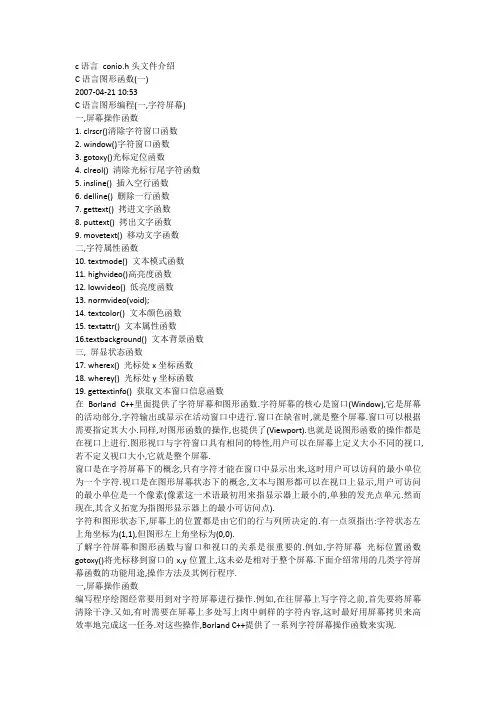
c语言conio.h头文件介绍C语言图形函数(一)2007-04-21 10:53C语言图形编程(一,字符屏幕)一,屏幕操作函数1. clrscr()清除字符窗口函数2. window()字符窗口函数3. gotoxy()光标定位函数4. clreol() 清除光标行尾字符函数5. insline() 插入空行函数6. delline() 删除一行函数7. gettext() 拷进文字函数8. puttext() 拷出文字函数9. movetext() 移动文字函数二,字符属性函数10. textmode() 文本模式函数11. highvideo()高亮度函数12. lowvideo() 低亮度函数13. normvideo(void);14. textcolor() 文本颜色函数15. textattr() 文本属性函数16.textbackground() 文本背景函数三, 屏显状态函数17. wherex() 光标处x坐标函数18. wherey() 光标处y坐标函数19. gettextinfo() 获取文本窗口信息函数在Borland C++里面提供了字符屏幕和图形函数.字符屏幕的核心是窗口(Window),它是屏幕的活动部分,字符输出或显示在活动窗口中进行.窗口在缺省时,就是整个屏幕.窗口可以根据需要指定其大小.同样,对图形函数的操作,也提供了(Viewport).也就是说图形函数的操作都是在视口上进行.图形视口与字符窗口具有相同的特性,用户可以在屏幕上定义大小不同的视口,若不定义视口大小,它就是整个屏幕.窗口是在字符屏幕下的概念,只有字符才能在窗口中显示出来,这时用户可以访问的最小单位为一个字符.视口是在图形屏幕状态下的概念,文本与图形都可以在视口上显示,用户可访问的最小单位是一个像素(像素这一术语最初用来指显示器上最小的,单独的发光点单元.然而现在,其含义拓宽为指图形显示器上的最小可访问点).字符和图形状态下,屏幕上的位置都是由它们的行与列所决定的.有一点须指出:字符状态左上角坐标为(1,1),但图形左上角坐标为(0,0).了解字符屏幕和图形函数与窗口和视口的关系是很重要的.例如,字符屏幕光标位置函数gotoxy()将光标移到窗口的x,y位置上,这未必是相对于整个屏幕.下面介绍常用的几类字符屏幕函数的功能用途,操作方法及其例行程序.一,屏幕操作函数编写程序绘图经常要用到对字符屏幕进行操作.例如,在往屏幕上写字符之前,首先要将屏幕清除干净.又如,有时需要在屏幕上多处写上肉中刺样的字符内容,这时最好用屏幕拷贝来高效率地完成这一任务.对这些操作,Borland C++提供了一系列字符屏幕操作函数来实现.1. clrscr()清除字符窗口函数功能:函数clrscr()清除整个当前字符窗口,并且把光标定位于左上角(1,1)处.用法:此函数调用方式为void clrscr(void);说明:括号中void 表示无参数.该函数相应的头文件为conio.h返回值:无例:使用这个函数的例子见4.clreol()函数的实例中.2. window()字符窗口函数功能: 函数window()用于在指定位置建立一个字符窗口.用法: 此函数调用方式为void window(int left,int top,int right,int bottom);说明: 函数中参数left,top为窗口左上角坐标;right,bottom为其右下角坐标.若有一个坐标是无效的,则window()函数不起作用.一旦该函数调用成功,那么所有定位坐标都是相对于窗口的,而不是相对于整个屏幕.但是建立窗口所用的坐标总是相对整个屏幕的绝对坐标,而不是相对当前窗口的相对坐标.这样用户就可以根据各种需要建立多个互不嵌套的窗口.此函数的头文件为conio.h.返回值:无例: 调用这个函数的实现例见3.gotoxy()函数的例子中.3. gotoxy()光标定位函数功能: 函数gotoxy()将字屏幕上的光标移到当前窗口指定的位置上.用法: 这个函数调用方式为void gotoxy(int x,int y);说明: 括号里x,y是, 光标定位的坐标,如果其中一个坐标值无效(如坐标超界),那么光标不会移动.此函数在字符状态(有时称为文本状态)下经常用到,其相应的头文件为conio.h返回值:无例: 下面程序建立两个窗口,然后在窗口里显示字符,字符的位置是调用该函数确定的.#include"conio.h>void border(int startx,int starty,int endx,int endy){register int i;gotoxy(1,1);for(i=0;i<=endx-startx;i++)putch('-');gotoxy(1,endy-starty);for(i=0;i<=endx-startx;i++)putch('-');for(i=2;ivoid main(){register int i;gotoxy(6,8);printf("This is a test of the clreol() function.");getch();gotoxy(6,8);for(i=0;i<20;i++)printf("Hello\n");getch();clrscr();}5. insline() 插入空行函数功能: 函数insline()插入一空行到当前光标所在行上,同时光标以下的所有行都向下顺移一行.用法: 此函数的调用方式为void insline(void);说明: 该函数只用于文本方式,并且在当了符窗口才有效.这个函数的对应头文件是conio.h返回值:无例: 程序给出了insline()函数的用法.#include "conio.h"void main(){registser int i;clrscr();for(i=1;i<24;i++){gotoxy(1,i);printf("This is line %d\n",i);}getch();gotoxy(1,10);insline();getch();}6. delline() 删除一行函数功能: 函数delline()删除当前窗口内光标所在行,同时把该行下面所有行都上移一行.用法: 此函数调用方式为void delline(void);说明: 注意,如果当前窗口小于整个屏幕,那么该函数只影响到窗口内的字符.这个函数相应的头部文件是conio.h返回值: 无例:先在屏幕上显示16行文字,然后删除第4行#include "conio.h"void main(){register int i;clrscr();for(i=0;i<16;i++) printf("line %d\n",i);getch();gotoxy(1,4);getch();}7.gettext() 拷进文字函数功能: 函数gettext()用于文本状态下将屏幕上矩形域内的文字拷进内存.用法: 该函数调用方式为int gettext(int left,int top,int right,int bottom,void *buffer);说明: 函数中参数left,top为矩形区域的左上角坐标,right,bottom为其右下角坐标,这些坐标是屏幕的绝对坐标,不是窗口的相对坐标.buffer指针必须指向一个足够保存该矩形域内文字的内存.所用内存大小按下式计算:点头用字节数=矩形哉内的行数×矩形域的列数×2这里将行数乘以列数再乘以2的原因是保存屏幕上每个字符要用两个字节存储单元,一个字节存储单元存放字符本身,而另一个存放其属性.此函数相应的头文件是conio.h返回值: 若函数调用成功则返回1,否则返顺0.例: 把屏幕左上角点(1,1)和右下角点(10,10)的区域拷贝到buf指向的内存中去.buf=(char *)malloc(10*10*2);if(!buf)gettext(1,1,10,10,buf);8. puttext() 拷出文字函数功能: 函数puttext()把先前由gettext()保存到buffer指向的内存中的文字拷出到屏幕上一个矩形区域中.用法: 此函数调用方式为int puttext(int left,int top,int right,int bottom,void *buffer);说明: 函数里left,top为给出的屏幕上矩形区域的左上角点,right,bottom为其右下角点,其坐标是用屏幕的绝对坐标,而不是用窗口的相对坐标.该函数相应的头文件为conio.h返回值: 函数调用成功返回值为1,否则返回0.例: 屏幕上某个区域内容拷进buf指向的内存中,然后又将这些文字拷出到屏幕上新位置. buf=(char *)malloc(10*10*2);gettext(1,1,10,10,buf);puttext(16,16,30,30,buf);9. movetext() 移动文字函数功能: 函数movetext()将屏幕上一个矩形区域的文字移到另一个区域上.用法: 该函数调用方式为int movetext(int left,int top,int right,int bottom,int newleft,int newtop);说明: 上面left,top为矩形区域上角坐标,right,bottom为其右下角坐标,newleft,newright为移动到区域左上角坐标.这些坐标是屏幕的绝对坐标,不是窗口的相对坐标.若要把屏幕上一段文字移到屏幕的另一位置,那么使用movetext()函数比用gettext()然后再用puttext()效率更高.此函数相应的头文件是conio.h返回值: 如果有一个以上坐标无效,那么函数返回值为0,否则返回1.列: 把屏幕左上角点(8,8),右下角点(20,20)的矩形区域文字移动到左上角点(10,10)的位置上: movetext(8,8,20,20,10,10);10. textmode() 文本模式函数功能: 函数textmode()针屏幕设置为文本模式(或者说字符状态).用法: 函数调用方式为void textmode(int mode);说明: 参数mode必须为表1-2中所示的模式之一⑴以用模式名(符号值),也可以用其等价的整数值.表1-2 文本模式----------------------------------------------------------------模式名(符号值) 等价整数值说明BW40 0 40列黑白C 40 1 40列彩色BW80 2 80列黑白C 80 3 80列彩色MONO 7 80列单色LASTMODE -1 上次模式----------------------------------------------------------------调用该函数后,屏幕复位,并且所有字符的属性恢复其缺省值.此函数对应的头文件是conio.h返回值: 无例: 把屏幕设置为80列彩色模式textmode(C80);二,字符属性函数用户可以设置字符显示的高亮度或低亮度的写的符闪烁及其背景颜色等.具有这些操作的函数称为字符属性函数.除了仅支持单模式和单色的显示卡外,字符属性函数适用于其余所有的显示卡.11. highvideo()高亮度函数功能: 函数highvideo()设置屏幕为高亮度显示.用法: 此函数调用方式为void highvideo(void);说明: 调用该函数后,写到屏幕上的字符是高亮度的.此函数只适用于文本模式状态(或说字符屏幕状态).这个函数对应的头文件为conio.h返回值: 无例: 设置屏幕显示为高亮度的.highvideo();12. lowvideo() 低亮度函数功能: 函数lowvideo()设置屏幕为低亮度显示.用法: 该函数调用方式为void lowvideo(void);说明: 调用该函数后,此时写到屏幕上的字符是低亮度的.这个函数只适用于文本模式状态(或说字符屏幕状态).此函数相应的头文件是conio.h返回值: 无例: 设置屏幕显示为低亮度的lowvideo();13. normvideo(void);功能: 函数normvideo()设置屏幕为正常亮度显示.用法: 这个函数调用方式为void normvideo(void);说明: 调用该函数后,此时写到屏幕上的字符是正常亮度的,该函数只适用于文本模式状态(或说字符状屏幕状态).此函数相应的头文件为conio.h返回值: 无例: 设置屏幕显示为正常亮度.normvideo();14. textcolor() 文本颜色函数功能: 函数textcolor()设置字符屏幕下文本颜色(或字符颜色),它也可以用于使字符闪烁.用法: 这个函数调用方式为void textcolor(int color);说明: 函数中参数color的有效值可取表1-3中的颜色名(即宏名)或等价值.表1-3 颜色名与等价值---------------------------------------------------名等价值含义BLACK 0 黑BLUE 1 蓝GREEN 2 绿CYAN 3 青RED 4 红MAGENTA 5 洋红BROWN 6 棕LIGHTGRAY 7 淡灰DRAKGRAY 8 深灰LIGHTBLUE 9 淡蓝LIGHTGREEN 10 淡绿LIGHTCYAN 11 淡青LIGHTRED 12 淡红LIGHTMAGENTA 13 淡洋红YELLOW 14 黄WHITE 15 白BLINK 128 闪烁------------------------------------------------------------textcolor()函数执行后,只影响其后输出探险符颜色,而不改变已经在当前屏幕上的其它字符颜色.显然,如果需要输出的字符闪烁,只要将函数中参数color取为BLINK即可,如果要使字符带颜色闪烁,就必须将所选的颜色值与128作"或"运算.此函数相应的头文件是conio.h返回值: 无例: 下面程序段中第一条语句使输出的字符闪烁,第三条语句使字符输出为经色同时闪烁: textcolor(BLINK);printf("hello");textcolor(RED|BLINK);15. textattr() 文本属性函数功能: 函数textattr()用于设置文本属性,即字符背景颜色,字符本身颜色和字符闪烁与否.用法: 函数调用方式为void textattr(int attribute);说明: 设置字符背景颜色属性字节的最简单方法是,用所选的背景颜色值乘以16再与字符颜色值作按位或(OR)运算.例如需要红色背景,绿色字符,就设置成RED*16|GREEN,若还要字符闪烁,就把背景颜色值,字符颜色值与闪烁值一起按位作或运算.如蓝背景,黄字符且闪烁,就设置成为:YELLO|128|BLUE*16第0位用于设置字符颜色.此函数相应的头文件为conio.h返回值: 无例: 设置背景为蓝色,字符为红色并且字符闪烁:textattr(RED|128|BLUE*16);16.textbackground() 文本背景函数功能: 函数textbackground()设置字符屏幕下文本背景颜色(或字符背景颜色).用法: 此函数调用方式为void textbackground(int bcolor);说明: 参数bcolor 的有效值取表1-4背景颜色(即宏名)或等价值.表1-4 背景颜色与等价值-------------------------------------------------背景颜色等价值含义-------------------------------------------------BLACK 0 黑BLUE 1 蓝GREEN 2 绿CYAN 3 青RED 4 红MAGENTA 5 洋红BROWN 6 棕-------------------------------------------------调用该函数只影响后续写的字符背景颜色,而不改变当前显示在屏幕上的字符背景颜色.这个函数对应的头文件是conio.h返回值: 无例: 设置文本背景颜色为蓝色:textbackground(BLUE));三, 屏显状态函数这里提供三个在文本模式下屏幕显示状态的函数17. wherex() 光标处x坐标函数功能: 函数wherex()返回当前窗口中光标处横向坐标.用法: 此函数调用方式为int wherex(void);说明: 这个函数调用无参数,其对应的头文件是conio.h返回值: 函数调用成功,返回光标处x坐标值.例: 调用这个函数的实例见18.wherey()函数的例中.18. wherey() 光标处y坐标函数功能: 函数wherey()返回当前窗口中光标处纵向坐标.用法: 该函数调用方式为int wherey(void);说明: 此函数调用无参数,其相应的头文件是conio.h返回值: 函数调用成功,返回光标处y坐标值.例: 调作函数wherex()与wherey(),返回当前光标处x坐标与y坐标,并赋给整型变量xpos ,ypos.int xpos,ypos;xpos=wherex();ypos=wherey();19. gettextinfo() 获取文本窗口信息函数功能: 函数gettextinfo()获取当前文本窗口信息,并存放在实参结构中.用法: 函数调用方式为void gettextinfo(struct text-info *info);说明: 函数中参数info 为struct text-info结构型指针,struct text-info结构在此函数相应的头文件中定义为:struct text-info{unsigned char winleft; // 窗口左上角x坐标unsigned char wintop; // 窗口左上角y坐标unsigned char winright; // 窗口右下角x坐标unsigned char winbottom; // 窗口右下角y坐标unsigned char attribute; // 文本属性unsigned char normattr; // 正常属性unsigned char currmode; // 当前屏显模式unsigned char screenhight // 文本窗口高度(以行数计)unsigned char screenwidth; // 文本窗口宽度(以字符个数计)unsigned char curx; // 光标处x坐标unsigned char cury; // 光标处y坐标};记住,调用函数gettextinfo()时,要传递struct text-info结构型指针或该结构的首地址,不要传递结构变量本身.这个函数对应的头文件是conio.h返回值: 返回文本窗口角点坐标,高宽度,文本属性等值,并存放在info所指向的结构变量中.例: 程序语句说明如何正确调用gettextinfo()函数:struct text-info win-status;gettextinfo(&win-status);C语言图形编程(二,图形显示)一,确定显示卡二,选择显示模式三,图形显示20. detectgraph() 显示卡检测函数21. initgraph() 图形初始化函数22. getdrivername() 获取图形驱动程序名的指针23. getgraphmode() 获取图形模式函数24. getmoderange()获取模式值范围函数25. getmaxmode()获取最大显示模式函数26. getmodename()获取显示模式名函数27. graphdefaults()图形设置复位缺省值函数28. setgraphmode() 设置图形模式函数29. restorecrtmode() 恢复文本显示模式函数30. graphresult() 图形操作结果函数31. grpaherrormsg() 图形错误信息函数32. setgraphbufsize()设置图形缓冲区大小函数33. setactivepage() 设置可输出显示页函数34. setvisualpage() 设置可见显示页数35. closegraph()关闭图形模式函数一,确定显示卡微机系统显示部分由显示器(monitor)和显示卡(adapter)两部分组成.显示器是独立于主机的一种外部设备,显示卡或称显示适配卡,也有的称图形卡,是插在主机上的一块电路板.但也有的显示卡与主机板设计在一起.显示卡包括寄存器组,存储器和控制电路三大部分.其中存储器又包括显示RAM和ROM BIOS两部分,微机对显示屏幕的所有操作都是通过显示卡来实现的.因此要进行图形显示,首先要确定计算机上安装的是何种显示卡.一种方法是询问计算机或终端使用者,确定将要使用的显示卡类型.这种方法很难,因为甚至专业程序员也不总是能确定他正在使用什么样的硬件.另一种方法是用软件查询硬件以识别当前的配置.如果有一些识别硬件的标准,这就很简单了.在Borland C中对现在所使用的各种显示卡提供了支持,这只要调用detectgraph()函数就可以了,该函数为程序员确定计算机上使用的显示卡类型.二,选择显示模式显示模式是指显示卡支持的分辨率与相应的颜色配置.每台计算机都配置了某种类型显示卡,可以为该显示卡指定显示模式.三,图形显示进行图形显示首先要确定显示卡,然后选择其显示模式.这些工作都可以调用图形功能函数来完成,其实就是把适合于显示卡的图形驱动程序装入内存.如果图形驱动程序未装入内存,那么图形函数就不能操作.20. detectgraph() 显示卡检测函数功能: 函数detectgraph()在计算机上安装有显示卡的情况下,测定其显示卡的类型.用法: 此函数调用方式为void detectgraph(int *driver,int *mode);说明: 函数把driver所指向的整型变量设置为图形驱动程序的代码,把mode所指向的整型变量设置为显示卡支持的最高有效模式(即该显示卡能支持的最高分辨率).该函数相应的头文件为graphics.h返回值: 返回适合于该显示卡的图形驱动程序的代码(也称等价值),并存放在driver指向的变量中.若计算机系统中无图形硬件,则由driver指向的变量设置为-2.例: 检测计算机是否装有显示卡:int driver,mode;detectgraph(&driver,&mode);if(driver==-2){printf("no graphics adapter in the computer");exit(1);}21. initgraph() 图形初始化函数功能: 函数initgraph()用于初始化图形系统,把适合的图形驱动程序装入内存,设置图形函数所用的显示模式.用法: 该函数调用方式为void initgraph(int *driver,int *mode,char *path);说明: 1) 函数中参数driver指向图形驱动程序(或者等价值).在头部文件graphics.h中定义了图形驱动程序的宏名与其等价,如下:宏名等价值------------------------------DETECT 0CGA 1MCGA 2EGA 3EGA64 4EGAMONO 5IBM8514 6HERCMONO 7ATT400 8VGA 9PC3270 10--------------------------------注:在现在的计算机中,上表中的许多显示卡已经过时,不再使用.这样就不必担心图形驱动程序的准确名字,而只要用其等价值即可,若使用detect(即等价值0)时,initgraph()函数自动检测当前计算机中装有的显示卡类型,并且选用最大分辨率的显示模式.2)参数mode指向显示模式或用等价值(风表1-5),mode所指的值必须是有效模式之一.3)参数path指向图形驱动程序所在的路径,例如path="C:\TC\BG1".若没有指定路径,就在当前目录下寻找.一般图形驱动程序包含在.BGI文件中,这些文件是系统可以得到的.这个函数对应的头文件是graphics.h.返回值: 无例: 调用initgraph()自动检测硬件图形系统,并选用最大分辨率显示模式.init drver,mode;driver=DETECT;mode=0;initgraph(&driver,&mode,"");22. getdrivername() 获取图形驱动程序名的指针功能: 函数getdrivername()返回指向当前图形驱动程序名的指针.用法: 此函数调用方式为char *getdrivername(void);说明: 本函数可以用来检测显示卡,但只能在initgraph()设置图形驱动程序和显示模式之后调用.该函数相应的头文件为graphics.h返回值: 返回一指针,指向含有当前图形驱动程序名的字符串.例: 显示当前图形驱动程序名:#include#includevoid main(){int graphdriver=DETECT,graphmode;char *s;initgraph(&graphdriver,&graphmode,"");s=getdrivername();outtext("Using driver:");outtext(s);getch();closegraph();}23. getgraphmode() 获取图形模式函数功能: 函数getgrapgmode()返回当前图形模式.用法: 该函数调用方式为int getgraphmode(void);说明: getgraphmode()函数无参数调用.这个函数对应的头文件是graphics.h返回值: 返回initgraph()或setgraphmode()所设置的当前图形模式值.例: 显示当前图形模式的代码:printf("graphics mode is %d",getgraphmode());24. getmoderange()获取模式值范围函数功能: 函数getmoderange()返回指定的图形驱动程序能够支持的最低和最高模式值.用法: 函数调用方式为void getmoderange(int driver,int *lowmode,int himode);说明: 参数driver是用来调用此函数时,指定图形驱动程序等价值或宏名.其有效值如下:-------------------------------------宏名等价值-------------------------------------DETECT0CGA1MCGA2EGA3EGA644EGAMONO5IBM85146HERCMONO7ATT4008VGA9PC327010-------------------------------------注:上表中的许多显示卡在现在的计算机上已经过时,仅作参考.该函数想应的头文件为graphics.h返回值: 返回的最小和最大有效值存放在参数指针lowmode和himode分别指向的整型变量中.例: 显示当前图形硬件的显示模式的范围值:#include"graphics.h"void main(){int driver,mode;int low,high;mode=0;initgraph(&driver,&mode,"");getmoderange(driver,&low,&high);printf("mode range:%d--%d,low,high);getch();rstorecrtmode();}25. getmaxmode()获取最大显示模式函数功能: 函数getmaxmode()返回当前加载的图形驱动程序所支持的最大有效显示模式.用法: 函数调用方式为int getmaxmode(void);说明:本函数无参数调用,返回图形驱动程序所支持的最大显示模式,所有图形驱动程序支持从0到getmaxmode()函数返回值中的任一整数值(对应的显示模式).这个函数对应的头文件是graphics.h返回值:返回图形驱动程序所支持的显示模式最大值.例: 显示当前最大显示模式:printf("The maxmode of this driver is %d\n",getmaxmode());26. getmodename()获取显示模式名函数功能: 函数getmodename()可获取当前图形驱动程序支持的指定显示模式的名字.用法: 此函数调用方式为char *getmodename(int modecode);说明: 参数modecode为整型值.用以指定一显示模式值调用该函数.这个函数对应的头文件graphics.h返回值: 返回指定模式值的显示模式名.例: 显示当前最大显示模式名:#include#includevoid main(){int graphdriver=DETECT,graphmode;int modecode;char *s;initgraph(&graphdriver,&graphmode,"");modecode=getmaxmode();s=getmodename(modecode);outtext("The maxmode name is:");outtext(s);getch();closegraph();}27. graphdefaults()图形设置复位缺省值函数功能: 函数grpahdefaults()把所有图形设置复位为它们的缺省值,这包括把图形视口复位为全屏幕;当前位置定位在0,0;调色板,背景色和绘图色都被复位;填充颜色,填充图样,文本文字和排齐方式都返回到它位的缺省值.用法: 此函数调用方式为void graphdefaults(void);说明: 该函数无参数调用.这个函数相应的头文件为graphics.h返回值: 无例: 将图形系统恢复为其缺省值:graphdefaults();28. setgraphmode() 设置图形模式函数功能: 函数setgraphmode()用当前图形驱动程序有效的图形模式调用,一旦被调用,setgraphmode()选择一个新的图形模式.注意,图形显示模式必须事先由initgraph()初始化.用法: 该函数调用方式为void setgraphmode(int mode);说明: 参数mode调用时为指定的模式值.此函数相应的头部文件是graphics.h返回值: 无例: 把VGA图形卡设置为VGAMED模式:setgraphmode(VGAMED); // 图形系统已经初始化29. restorecrtmode() 恢复文本显示模式函数功能: 函数restrecrtmode()将显示模式恢复到调用initgraph()时检测出的初始文本模式.用法: 这个函数调用方式为void restorecrtmode(void);说明: 函数restorecrtmode()和setgraphmode()函数一起使用,可以实现文本与图形显示之间的切换.此函数对应的头文件为graphics.h返回值: 无例: 恢复显示模式为初始文本模式:restorecrtmode();30. graphresult() 图形操作结果函数功能: 函数graphresult()函数返回最后一次图形操作的代码.用法: 此函数调用方式为int graphresult(void);说明: C为图形设置了代码,它们是从-15到0的整数值.其含义见表1-6.调用该函数时,出错状态被复位为0,所以返回值(代码)最好存于变量中,以供需要时检测,进行下一步图形操作.图形操作信息名称代码含义grOKgrNoInitGraphgrNoDetectedgrFileNoFoundgrInvalidDrivergrNoLoadMemgrNoScanMemgrNoFloadMemgrFontNotFoundgrNoFontMemgrInvalidModegrErrorgrIOerrorgrInvalidFontgrInvalidDeviceNum 0-1-2-3-4-5-6-7-8-9-10-11-12-13-14-15成功没有图形初始化没有检测到图形硬件没有找到图形驱动文件无效图形驱动程序没有足够内存装入图形驱动程序Scan填充内存不足Flood填充内存不足没有找到字体文件没有足够内存用于装字体文件无效图形模式一般图形错误输入输出错误无效字体文件无效字体号无效设备号这个函数对应的头部文件是graphics.h返回值: 返回最后一次图形操作结果相应的代码.例: 调用graphresult()函数的实例见下面grapherrormsg()函数的例子.31. grpaherrormsg() 图形错误信息函数功能: 函数grapherrormsg()返回指向出错代码相应的错误信息字符串的指针.用法: 此函数调用方式为char *grapherrormsg(int errcode);说明: 参数errcode值,即出错代码由调用函数graphresult()获得.这里所有出错代码及相应的错误信息如表1-6中所述.该函数相应的头文件是grpahics.h返回值: 返回一个指向该出错代码相应的错误信息字符串的指针.例: 用文字形式显示有关出错代码相应的错误信息:int errorcode;errorcode=graphresult();printf(%s",grapherrormsg(errcode));32. setgraphbufsize()设置图形缓冲区大小函数功能: 函数setgraphbufsize()用来设置有的图形函数(如floodfill等)所要用到的内存缓冲区大小.用法: 函数调用方式为unsigned setgraphbufsize(unsigned bufsize);说明: 这里无符号参数bufsize为所设置的缓冲区大小.一般不需要用到该函数,仅使用由initgraph()函数产生的内存缓冲区就够了,缓冲区大小缺省时为4KB(即4096个字节),足以用来填充一个大约有650个顶点的多边形,但是为了节省内存,用户可以减少缓冲区的大小,或者由于需要更多的缓冲区内存,这时可用函数setgraphbufsize()来增加缓冲区大小.注意,使用setgraphbufsize()函数必须在调用initgraph()之前.返回值: 返回先前定义的图形缓冲区字节数.例: 调用此函数设置图形缓冲区为8KB字节:setgraphbufsize(0x2000);33. setactivepage() 设置可输出显示页函数功能: 函数setactiveage()设置用作图形输出的显示页.用法: 这个函数调用方式为void setactivepage(int pagenum);说明: 参数pagenum为选择的显示页号,如果调用成功,那么后续图形输出就写到选定的输出页上.缺省时是以0页作为当前输出页.该函数只在图形驱动程序及其显示模式支持多个显示页时才起作用.此函数相应的头文件为graphics.h返回值: 无例: 设置1页为输出显示页:setactivepage(1);34. setvisualpage() 设置可见显示页数功能: 函数setvisualpage()设置屏幕上可见的显示页.用法: 函数调用方式为void setvisualpage(int pagenum);说明: 参数pagenum为设置的显示页号.缺省时是以0页作为当前可见页.调用这个函数和调用setactivepage()一样,仅在图形驱动程序及其显示模式支持多个显示页时才有效.用户可以用系统所支持的任何显示页,在它们之间切换,当然一次只能有一个显示页在屏幕上可见,有时需要在一页上建立后备图形葨图像,它在当时不显示,一旦需要时,可以马上切换到该页,如要实现动画效果,只需切换显示页号即可.用setvisualpage()函数选定实际显示在屏幕上的可见页,用setactivepage()函数选择当前图形输出页,从而实现图形页之间的显示切换,通常这两个函数都是缺省的,这时输出页就是可见页.若不绘制动画就不需要用到这两个函数.这两个函数对应的头文件是graphics.h返回值: 无例: 设置可见页为第1页:setvisualpage(1);35. closegraph()关闭图形模式函数功能: 函数closegraph()将系统图形模式关闭,,复位到initgraph()初始文本模式,并且释放图形驱动程序,字体和内部缓冲区所占用的系统内存.用法: 这个函数调用方式为void closegraph(void);说明: 当用户的程序既用到图形输出又用到非图形输出时,应该调用此函数.特别是程序多次调用initgraph()函数的情况,要相应地调用closegraph函数,释放调用initgraph()所占用的内存,否则内存很快就满了,程序无法运行,如果程序结束,也可以用restorecrtmode()函数代替该函。
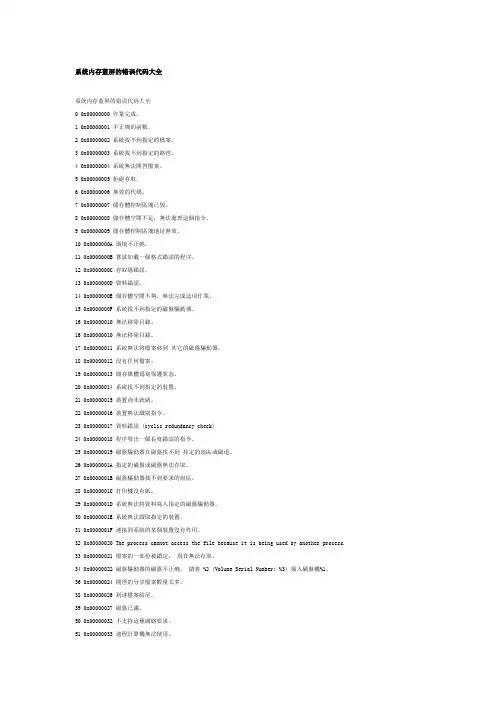
系统内存蓝屏的错误代码大全系统内存蓝屏的错误代码大全0 0x00000000 作業完成。
1 0x00000001 不正确的函數。
2 0x00000002 系統找不到指定的檔案。
3 0x00000003 系統找不到指定的路徑。
4 0x00000004 系統無法開啓檔案。
5 0x00000005 拒絕存取。
6 0x00000006 無效的代碼。
7 0x00000007 儲存體控制區塊已毀。
8 0x00000008 儲存體空間不足,無法處理這個指令。
9 0x00000009 儲存體控制區塊地址無效。
10 0x0000000A 環境不正确。
11 0x0000000B 嘗試加載一個格式錯誤的程序。
12 0x0000000C 存取碼錯誤。
13 0x0000000D 資料錯誤。
14 0x0000000E 儲存體空間不夠,無法完成這項作業。
15 0x0000000F 系統找不到指定的磁盤驅動器。
16 0x00000010 無法移除目錄。
16 0x00000010 無法移除目錄。
17 0x00000011 系統無法将檔案移到其它的磁盤驅動器。
18 0x00000012 沒有任何檔案。
19 0x00000013 儲存媒體爲寫保護狀态。
20 0x00000014 系統找不到指定的裝置。
21 0x00000015 裝置尚未就緒。
22 0x00000016 裝置無法識别指令。
23 0x00000017 資料錯誤 (cyclic redundancy check)24 0x00000018 程序發出一個長度錯誤的指令。
25 0x00000019 磁盤驅動器在磁盤找不到持定的扇區或磁道。
26 0x0000001A 指定的磁盤或磁盤無法存取。
27 0x0000001B 磁盤驅動器找不到要求的扇區。
28 0x0000001C 打印機沒有紙。
29 0x0000001D 系統無法将資料寫入指定的磁盤驅動器。
30 0x0000001E 系統無法讀取指定的裝置。
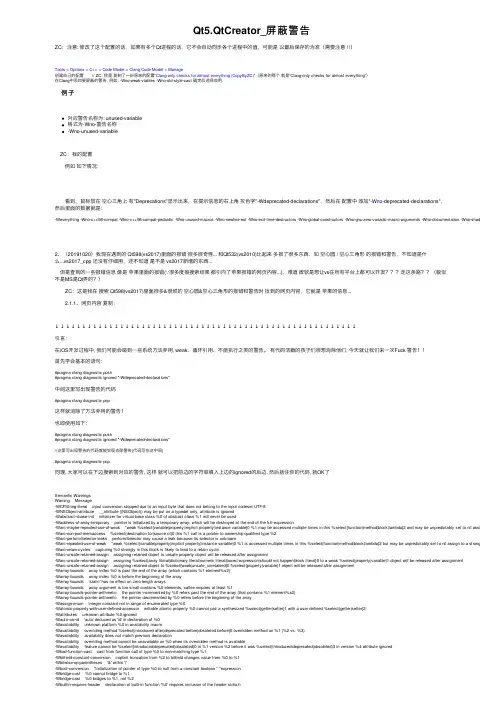
Qt5.QtCreator_屏蔽警告ZC:注意: 修改了这个配置的话,如果有多个Qt进程的话,它不会⾃动同步各个进程中的值,可能是以最后保存的为准(需要注意 ! !)Tools > Options > C++ > Code Model > Clang Code Model > Manage创建⾃⼰的配置 // ZC: 我是复制了⼀份原来的配置“Clang-only checks for almost everything (CopyByZC)”(原来的那个就是“Clang-only checks for almost everything”)在Clang中添加要屏蔽的警告, 例如: -Wno-weak-vtables -Wno-old-style-cast 确定后选择应⽤. 例⼦对应警告名称为: unused-variable格式为-Wno-警告名称-Wno-unused-variable ZC:我的配置 例如如下情况: 看到,⿏标放在空⼼三⾓上有"Deprecations"显⽰出来,在提⽰信息的右上⾓灰⾊字"-Wdeprecated-declarations",然后在配置中添加"-W no-deprecated-declarations",然后⾥⾯的数据就是:-Weverything -Wno-c++98-compat -Wno-c++98-compat-pedantic -Wno-unused-macros -Wno-newline-eof -Wno-exit-time-destructors -Wno-global-constructors -Wno-gnu-zero-variadic-macro-arguments -Wno-documentation -Wno-shadow -Wno-swit 2、(20191020)我现在遇到的 Qt598(vs2017)⾥⾯的报错很多很奇怪... 和Qt532(vs2010)⽐起来多报了很多东西,如空⼼圆 / 空⼼三⾓形的报错和警告,不知道是什么...vs2017_cpp 还没有仔细⽤,还不知道是不是 vs2017新增的东西... 但是查到的⼀些报错信息像是苹果⾥⾯的报错(∵很多度娘搜索结果都引向了苹果报错的⽹页内容...),难道微软是想让vs在所有平台上都可以开发⾛这条路??(貌似不是MS是Qt弄的?) ZC:这是我在搜索 Qt598(vs2017)⾥⾯很多&很烦的空⼼圆&空⼼三⾓形的报错和警告时找到的⽹页内容,它就是苹果的信息... 2.1.1、⽹页内容复制:↓↓↓↓↓↓↓↓↓↓↓↓↓↓↓↓↓↓↓↓↓↓↓↓↓↓↓↓↓↓↓↓↓↓↓↓↓↓↓↓↓↓↓↓↓↓↓↓↓↓↓↓↓↓↓↓引⾔:在iOS开发过程中, 我们可能会碰到⼀些系统⽅法弃⽤, weak、循环引⽤、不能执⾏之类的警告。
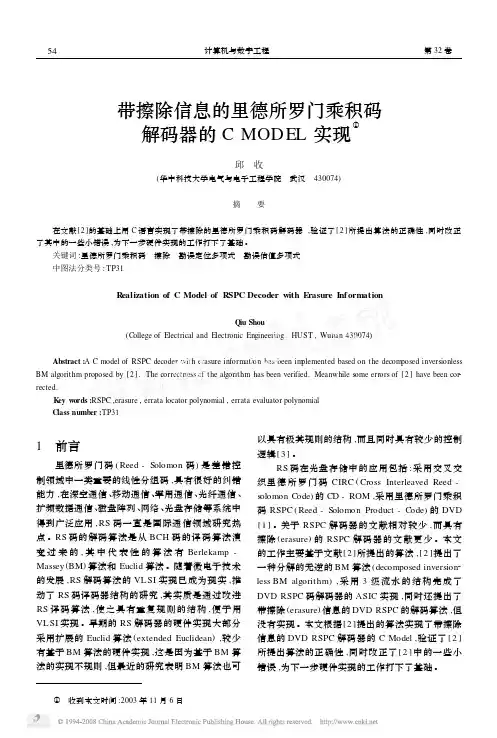
带擦除信息的里德所罗门乘积码解码器的C MODEL实现①邱 收(华中科技大学电气与电子工程学院 武汉 430074)摘 要在文献[2]的基础上用C语言实现了带擦除的里德所罗门乘积码解码器,验证了[2]所提出算法的正确性,同时改正了其中的一些小错误,为下一步硬件实现的工作打下了基础。
关键词:里德所罗门乘积码 擦除 勘误定位多项式 勘误估值多项式中图法分类号:TP31R ealization of C Model of RSPC Decoder with E rasure InformationQ iu Shou(College of Electrical and Electronic Engineering,HUST,Wuhan430074)Abstract:A C model of RSPC decoder with erasure information has been im plemented based on the decom posed inversionless BM algorithm proposed by[2].The correctness of the algorithm has been verified.Meanwhile some errors of[2]have been cor2 rected.K ey w ords:RSPC,erasure,errata locator polynomial,errata evaluator polynomialClass number:TP311 前言里德所罗门码(Reed-Solomon码)是差错控制领域中一类重要的线性分组码,具有很好的纠错能力,在深空通信、移动通信、军用通信、光纤通信、扩频数据通信、磁盘阵列、网络、光盘存储等系统中得到广泛应用,RS码一直是国际通信领域研究热点。
RS码的解码算法是从BCH码的译码算法演变过来的,其中代表性的算法有Berlekamp-Massey(BM)算法和Euclid算法。
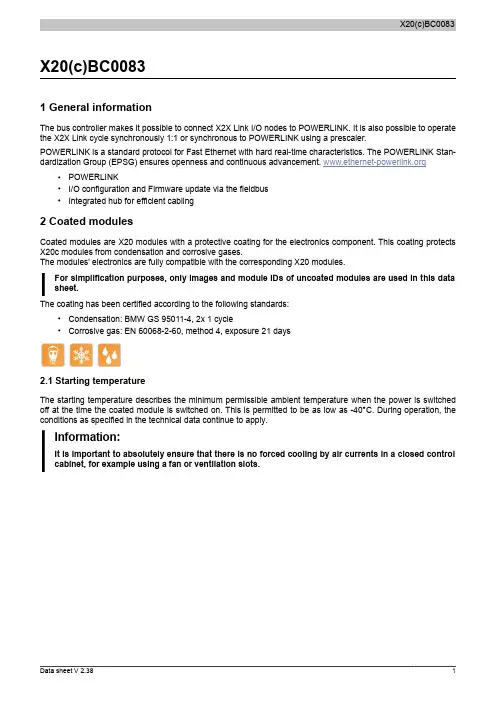
X20(c)BC00831 General informationThe bus controller makes it possible to connect X2X Link I/O nodes to POWERLINK. It is also possible to operate the X2X Link cycle synchronously 1:1 or synchronous to POWERLINK using a prescaler.POWERLINK is a standard protocol for Fast Ethernet with hard real-time characteristics. The POWERLINK Stan-dardization Group (EPSG) ensures openness and continuous advancement. •POWERLINK•I/O configuration and Firmware update via the fieldbus•Integrated hub for efficient cabling2 Coated modulesCoated modules are X20 modules with a protective coating for the electronics component. This coating protects X20c modules from condensation and corrosive gases.The modules' electronics are fully compatible with the corresponding X20 modules.For simplification purposes, only images and module IDs of uncoated modules are used in this data sheet.The coating has been certified according to the following standards:•Condensation: BMW GS 95011-4, 2x 1 cycle•Corrosive gas: EN 60068-2-60, method 4, exposure 21 days2.1 Starting temperatureThe starting temperature describes the minimum permissible ambient temperature when the power is switched off at the time the coated module is switched on. This is permitted to be as low as -40°C. During operation, the conditions as specified in the technical data continue to apply.Information:It is important to absolutely ensure that there is no forced cooling by air currents in a closed control cabinet, for example using a fan or ventilation slots.3 Order dataTable 1: X20BC0083, X20cBC0083 - Order data 4 Technical dataTable 2: X20BC0083, X20cBC0083 - Technical dataTable 2: X20BC0083, X20cBC0083 - Technical data1)See Automation Help under "Communication / POWERLINK / General information / Hardware - CN" for more information.2)The minimum cycle time specifies the time up to which the bus cycle can be reduced without communication errors occurring.3)Spacing is based on the width of bus base X20BB80. In addition, power supply module X20PS9400 or X20PS9402 is always required for the bus controller.5 Operating and connection elements5.1 LED status indicators1)The Status/Error LED "S/E" is a green/red dual LED. LED status indicators - Blink times5.2 POWERLINK node numberThe node number for the POWERLINK node is set using the two number switches.5.3 Ethernet interfaceFor information about wiring X20 modules with an Ethernet interface, see section "Mechanical and electrical con-figuration - Wiring guidelines for X20 modules with Ethernet cables" of the X20 user's manual.Ethernet RXD 6 Dynamic node allocation (DNA)Most POWERLINK bus controllers have the ability to dynamically assign node numbers. This has the following advantages:•No setting of the node number switch •Easier installation•Reduced error sourcesFor information regarding configuration as well as an example, see Automation Help → Communication → POW-ERLINK → General information → Dynamic node allocation (DNA)Information:Interface IF1 must always be used as the input from the preceding node.7 SG3This module is not supported on SG3 target systems.8 SG4The module comes with preinstalled firmware. The firmware is also part of the Automation Runtime operating system for the PLC. With different versions, the Automation Runtime firmware is loaded onto the module.The latest firmware is made available automatically when updating Automation Runtime.。
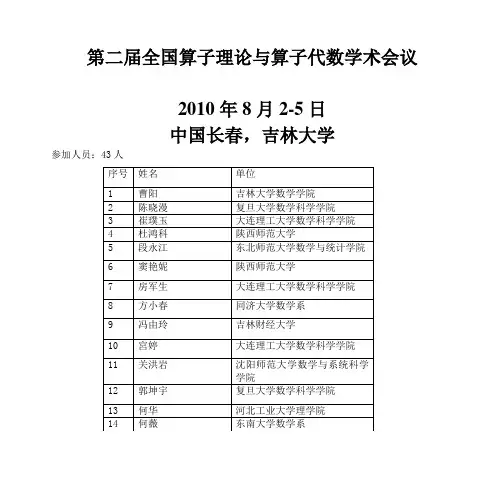
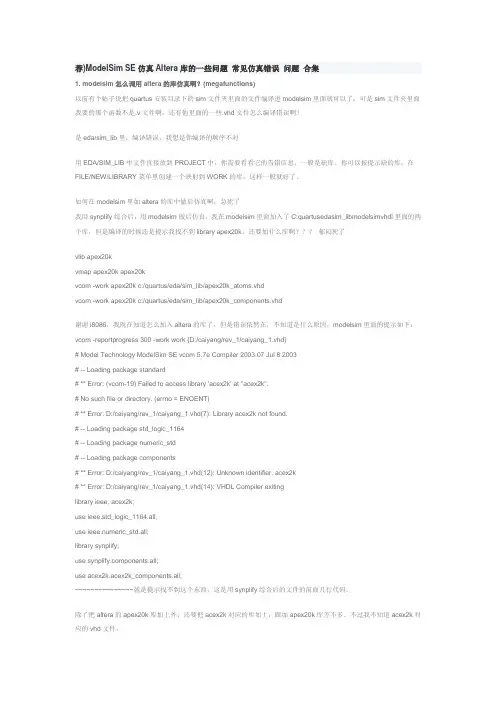
荐)ModelSim SE仿真Altera库的一些问题常见仿真错误问题合集1. modelsim怎么调用altera的库仿真啊?(megafunctions)以前有个帖子说把quartus安装目录下的sim文件夹里面的文件编译进modelsim里面就可以了,可是sim文件夹里面我要的那个函数不是.v文件啊,还有他里面的一些.vhd文件怎么编译错误啊?是eda/sim_lib里,编译错误,我想是你编译的顺序不对用EDA/SIM_LIB中文件直接放到PROJECT中,你需要看看它的告错信息。
一般是缺库。
你可以按提示缺的库,在FILE/NEW/LIBRARY菜单里创建一个映射到WORK的库。
这样一般就好了。
如何在modelsim里如altera的库中做后仿真啊,急死了我用synplify综合后,用modelsim做后仿真,我在modelsim里面加入了C:quartusedasim_libmodelsimvhdl里面的两个库,但是编译的时候还是提示我找不到library apex20k。
还要加什么库啊???郁闷死了vlib apex20kvmap apex20k apex20kvcom -work apex20k c:/quartus/eda/sim_lib/apex20k_atoms.vhdvcom -work apex20k c:/quartus/eda/sim_lib/apex20k_components.vhd谢谢i8086,我现在知道怎么加入altera的库了,但是错误依然在,不知道是什么原因,modelsim里面的提示如下:vcom -reportprogress 300 -work work {D:/caiyang/rev_1/caiyang_1.vhd}# Model Technology ModelSim SE vcom 5.7e Compiler 2003.07 Jul 8 2003# -- Loading package standard# ** Error: (vcom-19) Failed to access library 'acex2k' at "acex2k".# No such file or directory. (errno = ENOENT)# ** Error: D:/caiyang/rev_1/caiyang_1.vhd(7): Library acex2k not found.# -- Loading package std_logic_1164# -- Loading package numeric_std# -- Loading package components# ** Error: D:/caiyang/rev_1/caiyang_1.vhd(12): Unknown identifier: acex2k# ** Error: D:/caiyang/rev_1/caiyang_1.vhd(14): VHDL Compiler exitinglibrary ieee, acex2k;use ieee.std_logic_1164.all;use ieee.numeric_std.all;library synplify;use ponents.all;use acex2k.acex2k_components.all;~~~~~~~~~~~~~~~就是提示找不到这个东西,这是用synplify综合后的文件的前面几行代码。
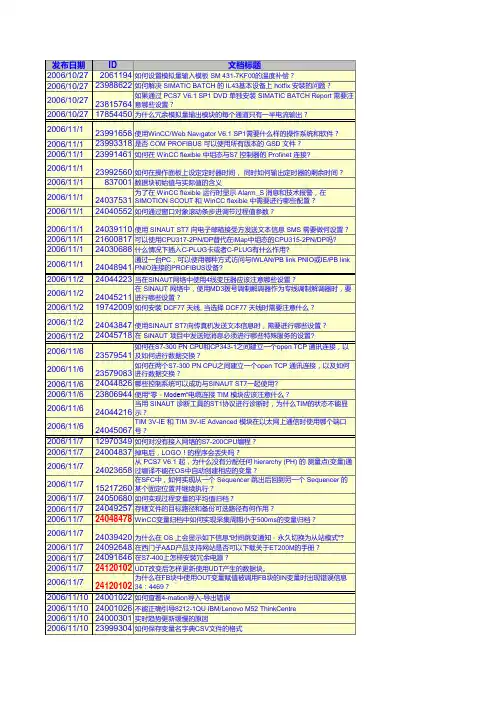
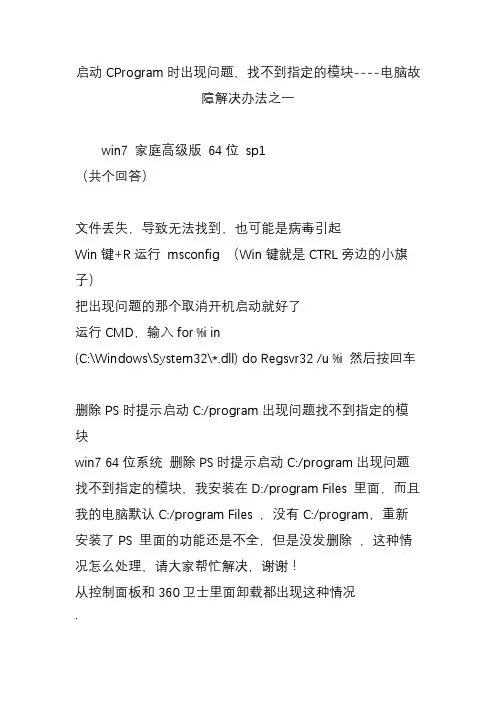
启动CProgram时出现问题,找不到指定的模块----电脑故障解决办法之一win7 家庭高级版64位sp1(共个回答)文件丢失,导致无法找到,也可能是病毒引起Win键+R运行msconfig (Win键就是CTRL旁边的小旗子)把出现问题的那个取消开机启动就好了运行CMD,输入for %i in(C:\Windows\System32\*.dll) do Regsvr32 /u %i 然后按回车删除PS时提示启动C:/program出现问题找不到指定的模块win7 64位系统删除PS时提示启动C:/program出现问题找不到指定的模块,我安装在D:/program Files 里面,而且我的电脑默认C:/program Files ,没有C:/program,重新安装了PS 里面的功能还是不全,但是没发删除,这种情况怎么处理,请大家帮忙解决,谢谢!从控制面板和360卫士里面卸载都出现这种情况·最佳答案可能是你卸载某软件的时候没卸载干净。
win+r 键,运行里面输入msconfig 然后确定。
选择启动。
然后选择你报错的那个路径,去掉前面钩钩。
确定就可以了。
系统找不到指定的模块,这是你误删了系统启动时要加载的驱动程序,这个问题不大,或者用以下几种方法解决:1、只要用系统盘修复一下即可。
2、如果是装的2000以上版本,可用系统的还原功能。
(打开开始-程序-附件-系统工具-还原,选择一个你所需要还原的日期,点击下一步、下一步就OK了。
)3、还可以重新安装一下你机器里的所有驱动,这样就差不多了。
电脑开机出现“启动C:\Program时出现问题找不到指定的模块”怎么办?如图所示,每次开机都是这样的,不知道什么原因,各位大神知道的帮忙看一下,谢谢!最新回答(4条回答)第一360杀毒软件查杀病毒木马第二清理桌面图标,桌面图标过多也会造成电脑启动的时候扫描时间过长。
第三下载360安全卫士,进行木马查杀和系统进行修复,优化下系统把不要的开机启动关掉!清理下恶性插件和系统垃圾!在重启一下!就会快很多清理系统垃圾等等!第四点击开始- 运行-输入msconfig-确定--启动---除了360杀毒软件其他的都取消,重新启动电脑全部答案(共1个回答)这种情况分两种1、正常程序在你使用不正常的删除后,在启动列表是仍然有启动,所以有问题,你可以在运行是输入“msconfig”看看有没有什么程序启动被你删除了的2、是一个病毒感染的文件被你正常或不正常的删除了,病毒启动时加载不上,就提示,你可以上法看看,或者杀毒后进行磁盘扫描。
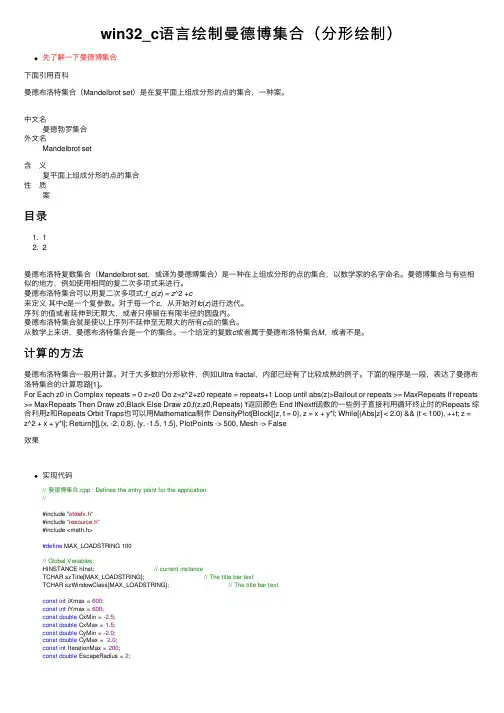
win32_c语⾔绘制曼德博集合(分形绘制)先了解⼀下曼德博集合下⾯引⽤百科曼德布洛特集合(Mandelbrot set)是在复平⾯上组成分形的点的集合,⼀种案。
中⽂名曼德勃罗集合外⽂名Mandelbrot set含义复平⾯上组成分形的点的集合性质案⽬录1. 12. 2曼德布洛特复数集合(Mandelbrot set,或译为曼德博集合)是⼀种在上组成分形的点的集合,以数学家的名字命名。
曼德博集合与有些相似的地⽅,例如使⽤相同的复⼆次多项式来进⾏。
曼德布洛特集合可以⽤复⼆次多项式:f_c(z) = z^2 +c来定义其中c是⼀个复参数。
对于每⼀个c,从开始对fc(z)进⾏迭代。
序列的值或者延伸到⽆限⼤,或者只停留在有限半径的圆盘内。
曼德布洛特集合就是使以上序列不延伸⾄⽆限⼤的所有c点的集合。
从数学上来讲,曼德布洛特集合是⼀个的集合。
⼀个给定的复数c或者属于曼德布洛特集合M,或者不是。
计算的⽅法曼德布洛特集合⼀般⽤计算。
对于⼤多数的分形软件,例如Ultra fractal,内部已经有了⽐较成熟的例⼦。
下⾯的程序是⼀段,表达了曼德布洛特集合的计算思路[1]。
For Each z0 in Complex repeats = 0 z=z0 Do z=z^2+z0 repeate = repeats+1 Loop until abs(z)>Bailout or repeats >= MaxRepeats If repeats >= MaxRepeats Then Draw z0,Black Else Draw z0,f(z,z0,Repeats) 'f返回颜⾊ End IfNextf函数的⼀些例⼦直接利⽤循环终⽌时的Repeats 综合利⽤z和Repeats Orbit Traps也可以⽤Mathematica制作 DensityPlot[Block[{z, t = 0}, z = x + y*I; While[(Abs[z] < 2.0) && (t < 100), ++t; z =z^2 + x + y*I]; Return[t]],{x, -2, 0.8}, {y, -1.5, 1.5}, PlotPoints -> 500, Mesh -> False效果实现代码// 曼德博集合.cpp : Defines the entry point for the application.//#include "stdafx.h"#include "resource.h"#include <math.h>#define MAX_LOADSTRING 100// Global Variables:HINSTANCE hInst; // current instanceTCHAR szTitle[MAX_LOADSTRING]; // The title bar textTCHAR szWindowClass[MAX_LOADSTRING]; // The title bar textconst int iXmax = 600;const int iYmax = 600;const double CxMin = -2.5;const double CxMax = 1.5;const double CyMin = -2.0;const double CyMax = 2.0;const int IterationMax = 200;const double EscapeRadius = 2;// Foward declarations of functions included in this code module:ATOM MyRegisterClass(HINSTANCE hInstance);BOOL InitInstance(HINSTANCE, int);LRESULT CALLBACK WndProc(HWND, UINT, WPARAM, LPARAM); LRESULT CALLBACK About(HWND, UINT, WPARAM, LPARAM);int APIENTRY WinMain(HINSTANCE hInstance,HINSTANCE hPrevInstance,LPSTR lpCmdLine,int nCmdShow){// TODO: Place code here.MSG msg;HACCEL hAccelTable;// Initialize global stringsLoadString(hInstance, IDS_APP_TITLE, szTitle, MAX_LOADSTRING);LoadString(hInstance, IDC_MY, szWindowClass, MAX_LOADSTRING);MyRegisterClass(hInstance);// Perform application initialization:if (!InitInstance (hInstance, nCmdShow)){return FALSE;}hAccelTable = LoadAccelerators(hInstance, (LPCTSTR)IDC_MY);// Main message loop:while (GetMessage(&msg, NULL, 0, 0)){if (!TranslateAccelerator(msg.hwnd, hAccelTable, &msg)){TranslateMessage(&msg);DispatchMessage(&msg);}}return msg.wParam;}//// FUNCTION: MyRegisterClass()//// PURPOSE: Registers the window class.//// COMMENTS://// This function and its usage is only necessary if you want this code// to be compatible with Win32 systems prior to the 'RegisterClassEx'// function that was added to Windows 95. It is important to call this function // so that the application will get 'well formed' small icons associated// with it.//ATOM MyRegisterClass(HINSTANCE hInstance){WNDCLASSEX wcex;wcex.cbSize = sizeof(WNDCLASSEX);wcex.style = CS_HREDRAW | CS_VREDRAW;wcex.lpfnWndProc = (WNDPROC)WndProc;wcex.cbClsExtra = 0;wcex.cbWndExtra = 0;wcex.hInstance = hInstance;wcex.hIcon = LoadIcon(hInstance, (LPCTSTR)IDI_MY);wcex.hCursor = LoadCursor(NULL, IDC_ARROW);wcex.hbrBackground = (HBRUSH)(COLOR_WINDOW+1);wcex.lpszMenuName = (LPCSTR)IDC_MY;wcex.lpszClassName = szWindowClass;wcex.hIconSm = LoadIcon(wcex.hInstance, (LPCTSTR)IDI_SMALL); return RegisterClassEx(&wcex);}//// FUNCTION: InitInstance(HANDLE, int)//// PURPOSE: Saves instance handle and creates main window//// COMMENTS://// In this function, we save the instance handle in a global variable and// create and display the main program window.//BOOL InitInstance(HINSTANCE hInstance, int nCmdShow){HWND hWnd;hInst = hInstance; // Store instance handle in our global variablehWnd = CreateWindow(szWindowClass, szTitle, WS_OVERLAPPEDWINDOW,CW_USEDEFAULT, 0, CW_USEDEFAULT, 0, NULL, NULL, hInstance, NULL);if (!hWnd){return FALSE;}ShowWindow(hWnd, nCmdShow);UpdateWindow(hWnd);return TRUE;}//// FUNCTION: WndProc(HWND, unsigned, WORD, LONG)//// PURPOSE: Processes messages for the main window.//// WM_COMMAND - process the application menu// WM_PAINT - Paint the main window// WM_DESTROY - post a quit message and return////LRESULT CALLBACK WndProc(HWND hWnd, UINT message, WPARAM wParam, LPARAM lParam) {int wmId, wmEvent;PAINTSTRUCT ps;HDC hdc;TCHAR szHello[MAX_LOADSTRING];LoadString(hInst, IDS_HELLO, szHello, MAX_LOADSTRING);switch (message){case WM_COMMAND:wmId = LOWORD(wParam);wmEvent = HIWORD(wParam);// Parse the menu selections:switch (wmId){case IDM_ABOUT:DialogBox(hInst, (LPCTSTR)IDD_ABOUTBOX, hWnd, (DLGPROC)About);break;case IDM_EXIT:DestroyWindow(hWnd);break;default:return DefWindowProc(hWnd, message, wParam, lParam);}break;case WM_PAINT:{//添加⼤括号,使内部的变量初始化赋值编译通过hdc = BeginPaint(hWnd, &ps);// TODO: Add any drawing code here...int iX,iY;double Cx,Cy;double PixelWidth = (CxMax - CxMin)/iXmax;double PixelHeight;PixelHeight = (CyMax - CyMin)/iYmax;COLORREF color;double Zx,Zy;double Zx2,Zy2;INT Iteration;double ER2;ER2 = EscapeRadius *EscapeRadius;//依据曼德博集合计算原理,获取每个像素的属性for(iY = 0;iY < iYmax;iY++)//循环每⼀⾏{Cy = CyMin + iY*PixelHeight;if(fabs(Cy) < PixelHeight/2)Cy = 0.0;for(iX=0;iX < iXmax;iX++)//循环每⼀列{Cx = CxMin +iX* PixelHeight;Zx = Zy= Zy2=Zx2 = 0.0;Iteration = 0;//针对每个像素进⾏循环计算while(Iteration < IterationMax && ((Zx2 + Zy2)<ER2)){Zy = 2* Zx*Zy + Cy;Zx = Zx2 - Zy2 + Cx;Zx2 = Zx*Zx;Zy2 = Zy *Zy;Iteration++;}if(Iteration == IterationMax)color = RGB(0,0,0);//前景⾊⿊⾊elsecolor = RGB(255,255,255);//背景⾊⽩⾊SetPixel(hdc,iX,iY,color);}}// RECT rt;// GetClientRect(hWnd, &rt);// DrawText(hdc, szHello, strlen(szHello), &rt, DT_CENTER);EndPaint(hWnd, &ps);break;}case WM_DESTROY:PostQuitMessage(0);break;default:return DefWindowProc(hWnd, message, wParam, lParam);}return0;}// Mesage handler for about box.LRESULT CALLBACK About(HWND hDlg, UINT message, WPARAM wParam, LPARAM lParam) {switch (message){case WM_INITDIALOG:return TRUE;case WM_COMMAND:if (LOWORD(wParam) == IDOK || LOWORD(wParam) == IDCANCEL){EndDialog(hDlg, LOWORD(wParam));return TRUE;}break;}return FALSE;}。

hilbert矩阵预处理代码希尔伯特矩阵是一种非常有名的数学矩阵,通常用于测试数值计算算法的性能和准确性。
希尔伯特矩阵的元素都是1/(i+j+1),其中i 和j 分别是矩阵的行和列索引。
希尔伯特矩阵是一个对称正定矩阵,因此它的Cholesky 分解可以用于预处理。
Cholesky 分解是一种将对称正定矩阵分解为一个下三角矩阵和一个上三角矩阵的乘积的方法。
以下是使用Python 进行希尔伯特矩阵预处理的示例代码:```pythonimport numpy as npdef hilbert_matrix(n):return np.array([[1 / (i + j + 1) for j in range(n)] for i in range(n)])def cholesky_decomposition(hilbert_matrix):return np.linalg.cholesky(hilbert_matrix)def preprocess_hilbert_matrix(n):hilbert_matrix = hilbert_matrix(n)cholesky_matrix = cholesky_decomposition(hilbert_matrix)return cholesky_matrix# 示例用法n = 10preprocessed_matrix = preprocess_hilbert_matrix(n)print(preprocessed_matrix)```在上述代码中,我们首先定义了一个`hilbert_matrix`函数来生成一个n x n 的希尔伯特矩阵。
然后,我们定义了一个`cholesky_decomposition`函数来对希尔伯特矩阵进行Cholesky 分解。
最后,我们定义了一个`preprocess_hilbert_matrix`函数来对希尔伯特矩阵进行预处理,并返回Cholesky 分解后的矩阵。
树莓派自定义“灯带函数”作者:牟晓东来源:《电脑报》2021年第17期众所周知,函数是程序设计语言的“基石”,即“组织好的、可重复使用的、用来实现单一或相关功能的代码段”。
Python本身提供了功能丰富的“内置函数”,可以在命令行模式中输入“dir (__builtins__)”命令进行查看,例如求绝对值函数、求最大值和最小值函数,还包括input输入和print输出函数等(如图1)。
此時,可以直接在命令行交互模式下使用内置函数,比如输入“abs(-7)”来求解-7的绝对值,回车后就会返回数值7;输入“max(0,6,-99,28)”求解四个数中的最大值,就会返回数值28。
另外,Python还支持用户根据自己的不同需求进行自定义函数操作,比如编写一个能够同时求解二数之和、之差的函数sum_sub():def sum_sub(a,b):return(a+b,a-b)输入“sum_sub(8,5)”进行测试,回车后就会返回两个结果:13和3(如图2)。
在开源硬件编程中使用Python可以灵活地控制各种周边硬件,从而实现更为丰富的功能。
我们在树莓派中使用Python进行函数的自定义编写,控制灯带模仿现实生活中十字路口的红绿灯,分别是单函数“带参”的红绿灯带和双函数“无参”的红绿灯带。
1.准备工作将可编程ws281x灯带通过古德微扩展板的18号接口与树莓派连接,注意灯带的三根引线分别标注+5V、GND和Din,不要接反。
在树莓派中通过Python编程控制灯带需要安装rpi_ws281x库模块,因此需要通过“Windows的远程桌面”连接树莓派。
在控制终端命令行模式中输入命令:“sudo pip3 installrpi_ws281x adafruit-circuitpython-neopixel”,回车后等待进度条到达100%后会有“Successfully installed”的提示(如图3)。
2.Python单函数“带参”控制红绿灯带(1)首先,以“ws”为别名导入rpi_ws281x库:“import rpi_ws281x as ws”,再导入time库中的sleep函数:“from time import sleep”;接着,设置灯带中激活的“灯珠”数量LED_COUNT值为60:“LED_COUNT = 60”,灯带接入的端口号LED_PIN是18号:“LED_PIN = 18”,并且创建灯带对象strip,实例化PixelStrip,参数为LED_COUNT和LED_PIN:“strip = ws.PixelStrip (LED_COUNT, LED_PIN)”,语句“strip.begin()”的作用是对灯带进行初始化。
hilbert矩阵预处理代码Hilbert矩阵预处理是一种常用的数值计算方法,用于改善矩阵求解问题的稳定性和收敛性。
在本文中,我们将介绍Hilbert矩阵预处理的原理、应用和优缺点。
我们来了解一下Hilbert矩阵。
Hilbert矩阵是一个特殊的方阵,其中的元素由公式H(i,j) = 1/(i+j-1)计算得出。
这类矩阵具有良好的性质,但由于其特殊的结构,求解时往往面临数值不稳定和收敛慢的问题。
为了解决Hilbert矩阵求解问题,人们提出了Hilbert矩阵预处理方法。
预处理是一种通过改变原始矩阵的形式来提高求解效率和精度的技术。
Hilbert矩阵预处理的基本思想是利用Hilbert矩阵的特殊性质,将其转化为更易于求解的形式。
具体而言,Hilbert矩阵预处理可以通过以下步骤实现:1. 构造Hilbert矩阵H,其中的元素由公式H(i,j) = 1/(i+j-1)计算得出。
2. 对原始矩阵A进行预处理,得到预处理矩阵P。
预处理矩阵P的计算通常涉及到矩阵分解、矩阵逆运算等数值计算方法。
3. 将原始问题转化为预处理问题,即求解预处理矩阵P与向量b的乘积Pb = c。
由于预处理矩阵P的特殊性质,这个问题往往比原始问题更易于求解。
4. 解决预处理问题,得到向量c。
5. 利用向量c和预处理矩阵P,计算原始问题的解x。
Hilbert矩阵预处理的主要应用领域是线性方程组的求解。
线性方程组是一类重要的数学问题,广泛应用于科学计算、工程设计和经济管理等领域。
然而,由于线性方程组的系数矩阵往往具有较差的条件数,求解过程中容易出现数值不稳定和收敛慢的问题。
Hilbert矩阵预处理可以有效地改善线性方程组求解问题的稳定性和收敛性。
通过将原始问题转化为预处理问题,预处理矩阵P可以使得求解过程更加稳定和高效。
实际应用中,Hilbert矩阵预处理常常与迭代法等求解方法相结合,取得了良好的效果。
然而,Hilbert矩阵预处理也存在一些局限性。
电脑蓝屏代码解决方案大全电脑蓝屏代码大全0X0000000 操作完成0X0000001 不正确的函数0X0000002 系统找不到指定的文件0X0000003 系统找不到指定的路径0X0000004 系统无法打开文件0X0000005 拒绝存取0X0000006 无效的代码0X0000007 内存控制模块已损坏0X0000008 内存空间不足,无法处理这个指令0X0000009 内存控制模块位址无效0X000000A 环境不正确0X000000B 尝试载入一个格式错误的程序0X000000C 存取码错误0X000000D 资料错误0X000000E 内存空间不够,无法完成这项操作0X000000F 系统找不到指定的硬盘0X0000010 无法移除目录0X0000011 系统无法将文件移到其他的硬盘0X0000012 没有任何文件0X0000019 找不到指定扇区或磁道0X000001A 指定的磁盘或磁片无法存取0X000001B 磁盘找不到要求的装置0X000001C 打印机没有纸0X000001D 系统无法将资料写入指定的磁盘0X000001E 系统无法读取指定的装置0X000001F 连接到系统的某个装置没有作用0X0000021文件的一部分被锁定,现在无法存取0X0000024 开启的分享文件数量太多0X0000026 到达文件结尾0X0000027 磁盘已满0X0000036 网络繁忙0X000003B 网络发生意外的错误0X0000043 网络名称找不到0X0000050 文件已经存在0X0000052 无法建立目录或文件0X0000053 INT24失败(什麼意思?还请高手指点站长一二) 0X000006B 因为代用的磁盘尚未插入,所以程序已经停止0X000006C 磁盘正在使用中或被锁定0X000006F 文件名太长0X0000070 硬盘空间不足0X000007F 找不到指定的程序0X000045B 系统正在关机0X000045C 无法中止系统关机,因为没有关机的动作在进行中0X000046A 可用服务器储存空间不足0X0000475 系统BIOS无法变更系统电源状态0X000047E 指定的程序需要新的windows版本0X000047F 指定的程序不是windwos或ms-dos程序0X0000480 指定的程序已经启动,无法再启动一次0X0000481 指定的程序是为旧版的 windows所写的0X0000482 执行此应用程序所需的程序库文件之一被损0X0000483 没有应用程序与此项操作的指定文件建立关联0X0000484 传送指令到应用程序无效0X00005A2 指定的装置名称无效0X00005AA 系统资源不足,无法完成所要求的服务0X00005AB系统资源不足,无法完成所要求的服务0X00005AC系统资源不足,无法完成所要求的服务110 0x006E 系统无法开启指定的装置或档案。
注意:这里列出了一些简单问题的答案,希望能对新来的朋友有所帮助。
很多是别人网站的常见问题,我们也能用到,就顺便帖过来了1、怎样截图,发图:A:按键盘上的“print screen sys rq”键。
B:打开你的图形编辑器(如果没有的话,用“图画”也可。
)C:直接粘贴,然后另存为*.jpg。
D:看一下你的图片大小,这里不能超过100K。
E:在帖子的附件上传。
或用截图工具发图教程(1)(2)2、如何升级到cm3.965中文版A:首先下载cm0102英文版(解压缩需要WINRAR3.0以上版本)B:然后下载3.965补丁升级。
C:下载3.965免cd补丁D:最后下载cm中文版补丁注意:以上补丁都是在安装目录下运行,即有cm0102.exe的那个目录。
载中文版补丁的时候有个选项让你升级到3.965还是3.960注意一下。
3、怎样用虚拟光区升级硬盘版cm0102A:把cm0102.exe和cmgdi.exe两个文件压缩成虚拟光碟文件然后放入虚拟光驱,B:打开升级补丁就可以升级了。
C:根据要求升级完成后打3.965免cd补丁。
4.如何制作背景图片A、首先把cm0001的pictures的整个目录copy到cm2002的目录下。
B、用cm自带的piced进行图片编辑。
C,详细说明编辑器里都有background的大小是800X600的,自己找喜欢的图片用photoshop作一下D、先把图片存成bmp格式,然后用piced load,然后save background,就成了rgn文件了。
E、在pictures目录里面有一个pic.cfg吧,找出你的俱乐部的名字,根据已经有的模式,加上你做好的rgn文件就ok拉。
在DATA目录下有6个*.rgn文件分别是CM的默认的背景(就是在你选择背景不变时的背景)和游戏开始画面里的EIDOS、SI的那些画面,你可以用做好的背景文件改文件名覆盖这些文件,当游戏开始的时候你就可以看见这些图片而不是EIDOS、SI的LOGO了。
a rXiv:074.386v2[math.O A]1M a y27C 0-HILBERT MODULESYUN-SU KIM.Abstract.We provide the definition and fundamental proper-ties of algebraic elements with respect to an operator satisfying hypothesis (h ).Furthermore,we analyze Hilbert modules using C 0-operators relative to a bounded finitely connected region Ωin the complex plane.Introduction The theory of contractions of class C 0was developed by Sz.-Nagy-Foias [7],Moore-Nordgren [6],and Bercovici-Voiculescu [2,3],and J.A.Ball introduced the class of C 0-operators relative to a bounded finitely connected region Ωin the complex plane,whose boundary ∂Ωconsists of a finite number of disjoint,analytic,simple closed curves.The the-ory of Hilbert modules over function algebras has been developed by Ronald G.Douglas and Vern I.Paulsen [4].We analyze Hilbert modules using C 0-operators relative to Ω.Every operator T defined on a Hilbert space H satisfying hypothesis (h )is not a C 0-operator relative to Ω.Thus,we provide the definition of an algebraic element with respect to T .If B is the set of algebraic elements with respect to T ,and it is closed,then naturally we have a bounded operator T B from the quotient space H/B to H/B .In section 2,we discuss the relationships between the algebraic elements with respect to T B in H/B and the algebraicelements with respect to T in H .In section 3,we define a module action on a Hilbert space H by using a C 0-operator T relative to Ω,and introduce a C 0-Hilbert module H T .Naturally,this raises the following question :If every element of H T is algebraic with respect to T over A ,then T is either a C 0-operator or not.In this paper,we consider a case in which the rank of the C 0-Hilbert module H T is finite,and we show that if a generating set2YUN-SU KIM.{h1,···,h k}(k<∞)of a Hilbert module H T over A is contained in B, then T is a C0-operator.Furthermore,if B is closed,then by using the Jordan model of a C0-operator T relative toΩ,we show that there are locally maximal C0-submodules M i(i=0,1,2,···)of H T such that M0⊂M1⊂M2⊂···. The author would like to express her appreciation to Professors Hari Bercovici and Ronald G.Douglas for making some helpful comments on this paper.1.Preliminaries and Notation1.1.Hilbert Modules.Let X be a compact,separable,metric space and let C(X)denote the algebra of all continuous complex-valued func-tions on X.A function algebra on X is a closed subalgebra of C(X), which contains the constant functions and separates points of X.Definition1.1.Let F be a function algebra,and let H be a Hilbert space.We say that H is a Hilbert module over F if there is a separately continuous mappingφ:F×H→H in each variable satisfying:(a)φ(1,h)=h,(b)φ(fg,h)=φ(f,φ(g,h)),(c)φ(f+g,h)=φ(f,h)+φ(g,h),(d)φ(f,αh+βk)=αφ(f,h)+βφ(f,k),for every f,g in F,h,k in H,andαβin C.We will denoteφ(f,h)by f.h.For f in F,we let T f:H→H denote the linear map T f(h)=f.h.If H is a Hilbert module over F,then by the continuity in the second variable we have that T f is bounded.Definition1.2.Let H be a Hilbert module over F.Then the module bound of H,isK F(H)=inf{K: T f ≤K f for all f in A}.We call H contractive if K F(H)≤1.If H is a Hilbert module over A,then a set{hδ}δ∈Γ⊂H is called a generating set for H iffinite linear sums of the formi f i.hδi,f i∈A,δi∈Γare dense in H.Definition1.3.If H is a Hilbert module over A,then rank A(H),the rank of H over A,is the minimum cardinality of a generating set for H.C0-HILBERT MODULES3In the last few decades,the theory of Hilbert modules over function algebras has been developed by Ronald G.Douglas and Vern I.Paulsen [4].1.2.A Functional Calculus.Let H be a Hilbert space.Recall that H∞is the Banach space of all(complex-valued)bounded analytic func-tions on the open unit disk D with supremum norm[7].A contraction T in L(H)is said to be completely nonunitary if there is no invariant subspace K for T such that T|K is a unitary operator.B.Sz.-Nagy andC.Foias introduced an important functional calcu-lus for completely non-unitary contractions.Proposition1.4.Let T∈L(H)be a completely non-unitary contrac-tion.Then there is a unique algebra representationΦT from H∞into L(H)such that:(i)ΦT(1)=I H,where I H∈L(H)is the identity operator;(ii)ΦT(g)=T,if g(z)=z for all z∈D;(iii)ΦT is continuous when H∞and L(H)are given the weak∗-topology.(iv)ΦT is contractive,i.e. ΦT(u) ≤ u for all u∈H∞.We simply denote by u(T)the operatorΦT(u).B.Sz.-Nagy andC.Foias[7]defined the class C0relative to the open unit disk D consisting of completely non-unitary contractions T on H such that the kernel ofΦT is not trivial.If T∈L(H)is an operator of class C0,thenkerΦT={u∈H∞:u(T)=0}is a weak∗-closed ideal of H∞,and hence there is an inner function generating kerΦT.The minimal function m T of an operator of class C0is the generator of kerΦT.Also,m T is uniquely determined up to a constant scalar factor of absolute value one[2].The theory of class C0relative to the open unit disk has been developed by B.Sz.-Nagy,C.Foias([7])and H.Bercovici([2]).1.3.Hardy spaces.We refer to[9]for basic facts about Hardy space, and recall here the basic definitions.Definition1.5.The space H2(Ω)is defined to be the space of ana-lytic functions f onΩsuch that the subharmonic function|f|2has a harmonic majorant onΩ.For afixed z0∈Ω,there is a norm on H2(Ω) defined byf =inf{u(z0)1/2:u is a harmonic majorant of|f|2}.4YUN-SU KIM.Let m be harmonic measure for the point z0,let L2(∂Ω)be the L2-space of complex valued functions on the boundary ofΩdefined with respect to m,and let H2(∂Ω)be the set of functions f in L2(∂Ω)suchthat ∂Ωf(z)g(z)dz=0for every g that is analytic in a neighborhood of the closure ofΩ.If f is in H2(Ω),then there is a function f∗in H2(∂Ω)such that f(z)approaches f∗(λ0)as z approachesλ0nontangentially,for almost everyλ0relative to m.The map f→f∗is an isometryfrom H2(Ω)onto H2(∂Ω).In this way,H2(Ω)can be viewed as a closed subspace of L2(∂Ω).A function f defined onΩis in H∞(Ω)if it is holomorphic andbounded.H∞(Ω)is a closed subspace of L∞(Ω)and it is a Banachalgebra if endowed with the supremum norm.Finally,the mappingf→f∗is an isometry of H∞(Ω)onto a week∗-closed subalgebra of L∞(∂Ω).1.4.C0-operators relative toΩ.We will present in this section thedefinition of C0-operators relative toΩ.Reference to this material is found in Zucchi[10].Let H be a Hilbert space and K1be a compact subset of the complexplane.If T∈L(H)andσ(T)⊆K1,for r=p/q a rational function withpoles offK1,we can define an operator r(T)by q(T)−1p(T).Definition1.6.If T∈L(H)andσ(T)⊆K1,we say that K1is a spectral set for the operator T if r(T) ≤max{|r(z)|:z∈K1},whenever r is a rational function with poles offK1.If T∈L(H)is an operator withC0-HILBERT MODULES52.Algebraic Elements with respect to an Operatorsatisfying hypothesis(h)Every operator T satisfying hypothesis(h)is not a C0-operator rel-ative toΩ,and so we provide the following definition.Definition2.1.Let T∈L(H)be an operator satisfying hypothesis (h).An element h of H is said to be algebraic with respect to T provided thatθ(T)h=0for someθ∈H∞(Ω)\{0}.If not,h is said to be transcendental with respect to T.If A is a closed subspace of H generated by{a i∈H:i=1,2,3,···}, then A will be denoted by ∞n=1a i.Proposition2.2.Let T∈L(H)be an operator satisfying hypothesis (h).(a)If h∈H is algebraic with respect to T,then so is any element in ∞n=0T n h.(b)If h∈H is transcendental with respect to T,then so is T n h forany n=0,1,2,···.Proof.(a)Letθ∈H∞(Ω)\{0}such thatθ(T)h=0.Then for any n=0,1,2,···,θ(T)(T n h)=T n(θ(T)h)=0.It follows thatθ(T)h′=0for any h′∈ ∞n=0T n h.(b)Suppose that T k h is algebraic with respect to T for some k>0. Thus there is f∈H∞(Ω)\{0}such that f(T)T k h=0.Let f1(z)=z k f(z)for z∈D.Then f1∈H∞(Ω)\{0}andf1(T)h=T k f(T)h=f(T)T k h=0which contradicts to the fact that h is transcendental with respect to T. Note that T0denote the identity operator on H.By Theorem1in[8],if h∈H is algebraic with respect to T,then there is an inner function m h∈H∞(Ω)such that m h(T)h=0and m h is said to be a minimal function of h with respect to T.Theorem2.3.Let T∈L(H)be an operator satisfying hypothesis(h), and B={h∈H:h is algebraic with respect to T}.(a)If M={h i:i=1,2,···,k}(k<∞)is contained in B,then so is ∞n=0T n M.(b)B is a subspace of H.6YUN-SU KIM.Proof.(a)By Proposition2.2(a),(2.1)m hi(T)(T n h i)=0 for any i=1,···,k and n=0,1,2,···.Letθ=m h1···m hk.Thenθ∈H∞(Ω)\{0},andθ=θi m hifor someθi∈H∞(Ω)\{0}.Thus,by equation(2.1),(2.2)θ(T)(T n h i)=θi(T)m hi(T)(T n h i)=0for any i=1,···,k and n=0,1,2,···.If x∈ ∞n=0T n M,then there is a sequence{x n}∞n=1such thatlim n→∞x n=x and x n= k i=1a n,i P n,i(T)h ifor some a n,i∈C and a polynomial P n,i.Then,equation(2.2)implies thatθ(T)(x n)=θ(T)( k i=1a n,i P n,i(T)h i)= k i=1a n,iθ(T)P n,i(T)h i=0. It follows thatθ(T)(x)=0for any x∈ ∞n=0T n M.Thus x∈B. (b)Clearly,0∈B.For h1and h2in B,if m1(T)h1=m2(T)h2=0, where m i(i=1,2)∈H∞(Ω)\{0},then(m1m2)(T)(α1h1+α2h2)=0for anyαi(i=1,2)in C.Thus B is a subspace of H.Note that B does not need to be closed.If T is a bounded operator on H and M is a(closed)invariant sub-space for T,then we can define a bounded operator T M:H/M→H/M defined byT M([h])=[T h]where H/M is the quotient space.Since M is T-invariant,T M is well-defined.Clearly,T M is a bounded operator on H/M.Let R(Ω)be the algebra of rational functions with poles offC0-HILBERT MODULES7 Definition2.4.Let T∈L(H)be an operator satisfying hypothesis (h)and M be an invariant subspace for T.An element[h]of H/M is said to be algebraic with respect to T M provided thatθ(T M)[h]=0for someθ∈H∞(Ω)\{0}.If not,h is said to be transcendental with respect to T M.Proposition2.5.Let T∈L(H)be an operator satisfying hypothesis (h)and B={h∈H:h is algebraic with respect to T}.If B is closed, then it is R(Ω)-invariant.Proof.Let h∈B and u∈R(Ω).Then there is a nonzero function φ∈H∞(Ω)such thatφ(T)h=0.It follows that u(T)φ(T)h=φ(T)(u(T)h)=0,that is,u(T)h∈B. Theorem2.6.Let T∈L(H)be an operator satisfying hypothesis(h) and B={h∈H:h is algebraic with respect to T}.If B is a closed subspace of H,then the following statements are equivalent:(i)[a]∈H/B is algebraic with respect to T B.(ii)a is algebraic with respect to T.Proof.(i)→(ii)Since[a]∈H/B is algebraic with respect to T B,there is a nonzero functionθ1in H∞(Ω)such thatθ1(T)a∈B.It follows that(2.3)θ2(T)(θ1(T)a)=0for someθ2∈H∞(Ω)\{0}.Letθ3=θ1·θ2∈H∞(Ω)\{0}.Then by equation(2.3),θ3(T)a=0, and so a∈B.(ii)→(i)If a∈H is algebraic with respect to T,then there is a nonzero functionθin H∞(Ω)such thatθ(T)a=0.Since0∈B,θ(T B)[a]=[θ(T)a]=0. Corollary2.7.Under the same assumption as Theorem2.6,the fol-lowing statements are equivalent:(i)[a]∈H/B is algebraic with respect to T B.(ii)[a]=[0].Proof.By Theorem2.6,it is clear.Corollary2.8.Let T∈L(H)be an operator satisfying hypothesis(h) and M⊂B is a R(Ω)-invariant subspace for T.Then the following statements are equivalent:8YUN-SU KIM.(i)[a]∈H/M is algebraic with respect to T M.(ii)a is algebraic with respect to T.Proof.It can be proven by the same way as the proof of Theorem 2.6. Corollary2.9.Let T∈L(H)be an operator satisfying hypothesis(h) and M⊂B is a R(Ω)-invariant subspace for T.Then the following statements are equivalent:(i)[a]∈H/M is transcendental with respect to T M.(ii)a is transcendental with respect to T.We recall that if K is a Hilbert space,H is a subspace of K,V∈L(K),and T∈L(H),then V is said to be a dilation of T provided that(2.4)T=P H V|H.If T and V are operators satisfying hypothesis(h)and V is a C0-operator relative toΩsatisfying equation(2.4),then V is said to be a C0-dilation of T.We will not discuss about C0-dilation any more in this paper.Lemma2.10.Let T∈L(H)be an operator satisfying hypothesis(h) and B′={h∈H:h is transcendental with respect to T}.It h∈B′, then u(T)h∈B′for any u∈R(Ω)\{0}Proof.Suppose that there is an element h in B′such that u(T)h is algebraic with respect to T for some u∈R(Ω)\{0}.Thus there is a nonzero functionφ∈H∞(Ω)such that(2.5)φ(T)u(T)h=0.Letθ=φ·u.Thenθ∈H∞(Ω)\{0}such thatθ(T)h=0by equation(2.5).It contradicts to the fact that h∈B′.3.C0-Hilbert ModulesLet H be a Hilbert space and F be a function algebra on X.Then H is a Hilbert module over F with the module action F×H→H given byf.h=f(x)hfor afixed x∈X.Let H x denote this Hilbert module over F.Clearly, H x is a contractive Hilbert module over F for any x∈X. Similarly,for an operator T on H satisfying hypothesis(h),if A⊂H∞(Ω)is a function algebra overC0-HILBERT MODULES9 contained in A,then H is a Hilbert module over A with the module action A×H→H given by(3.1) f.h=f(T)h.In this paper,H T denotes this Hilbert module over A⊂H∞(Ω). Clearly,H T is a contractive Hilbert module over A.In this section,A denotes a function algebra over10YUN-SU KIM.Proof.It is proven by the same way as the proof of Proposition3.3.If T∈L(H)is an operator satisfying hypothesis(h)and M is a submodule of H T over A,then by the definition of module action given in equation(3.1),we have that M is T-invariant.Furthermore,M is a invariant subspace for each operator u(T)where u∈A.Definition3.5.Let T∈L(H)be an operator satisfying hypothesis (h).If M is a submodule of H T(over A)such that T|M:M→M is a C0-operator relative toΩ,then M is said to be a C0-submodule(over A)of H TDefinition3.6.Let T∈L(H).If there is an element h∈H which is not in the kernel of T such that{T n h:n=0,1,2,···}is not linearly independent,then T is said to be dependent.Theorem3.7.If T∈L(H)is a dependent operator satisfying hypoth-esis(h),then H T always has a nonzero C0-submodule M.Proof.Since T is dependent,there is a nonzero element h in H such that{T n h:n=0,1,2,···}(={0})is linearly dependent.It follows thatka n T i n h=0,n=0for some nonzero polynomial p(z)= k n=0a n z i n(z∈D).Let M be the closed subspace of H generated by{θ(T)h:θ∈A} and M′={f∈A:f(T)h=0}.Since p∈M′,M′is not empty. Clearly,f.k is in M for every f in A and k in M and so M is a submodule of H T.For anyθ∈A and f∈M′,f(T)θ(T)h=θ(T)f(T)h=0.It follows that f(T)h′=0for any f∈M′and h′∈M.Therefore,T0=T|M is a C0-operator relative toΩ,and so M is a C0-submodule of H T. Definition3.8.Let T∈L(H)be an operator satisfying hypothesis (h).A C0-submodule M of H T over A is said to be maximal provided that there is no submodule M′of H T over A such that M⊂M′and T|M′is a C0-operator relative toΩ.Corollary3.9.Let T∈L(H)be an operator satisfying hypothesis(h). If M is a maximal C0-submodule of H T and h∈H T\M,then{T n h: n=0,1,2,···}is linearly independent.C0-HILBERT MODULES11 Proof.Suppose that there is an element h∈H T\M such that{T n h: n=0,1,2,···}is linearly dependent.If M′is the closed subspace of H T generated by{θ(T)h:θ∈A}, then by Theorem3.7,T|M′is a C0-operator relative toΩ.Since T|M and T|M′are C0-operators relative toΩ,there are nonzero functions θi∈H∞(Ω)(i=1,2,)such that(3.5)θ1(T|M)=0andθ2(T|M′)=0.It follows thatθ1θ2(T|M∨M′)=0,that is,T|M∨M′is also a C0-operator relative toΩ.By maximality of M,M∨M′=M which contradicts to the fact that h∈M′\M.For an operator satisfying hypothesis(h),T∈L(H),h∈H is said to be algebraic with respect to T over A,provided thatθ(T)h=0for someθ∈A\{0}.If B={h∈H:h is algebraic with respect to T over A},then we could raise the question of whether the following sentence is true or not;If every element of H T is algebraic with respect to T over A,then T is a C0-operator.In the next Theorem,we provide a condition in which that sentence is true.Theorem3.10.Let T∈L(H)be an operator satisfying hypothesis(h). If H T is a Hilbert module over A with a generating set{h1,···,h k}(k<∞)and h i∈B for i=1,2,···,k,then H T=B and T is a C0-operator. Proof.Since h i∈B,there is a nonzero function m i in A such that m i(T)h i=0for i=1,2,···,k.Then for any f∈A,m i(T)(f.h i)= m i(T)f(T)h i=f(T)m i(T)h i=0.It follows that f.h i∈B for any f∈A.By Theorem2.3(b),{ k i=1f i.h i:f i∈A}is contained in B.Since { k i=1f i.h i:f i∈A}is dense in H T,it is enough to prove that B is a closed subspace of H T.Let b be an element in the closure of B in the norm topology induced by the inner product defined in H T.Then,there is a sequence{b n}∞n=1 in{ k i=1f i.h i:f i∈A}such that lim n→∞b n=b.Define a function m=m1···m k.Then,for any f i∈A,(3.6)m(T)(ki=1f i.h i)=m(T)(ki=1f i(T)h i)=ki=1f i(T)m(T)h i=0.12YUN-SU KIM.Equation(3.6)implies that m(T)(b n)=0for any n=1,2,···.Thus m(T)b=0so that b∈B.Therefore,H T=B.Since m(T)b=0for any b∈B(=H T),m(T)=0which proves that T is a C0-operator.Recall that a nonzero functionθin H(Ω)is said to be inner if|θ| is constant almost everywhere on each component of∂Ω.Then the Jordan block S(θ)is an operator acting on the space H(θ)=H2(Ω)⊖θH2(Ω)as follows:S(θ)=P H(θ)S|H(θ),where S∈L(H2(Ω))is defined by(Sf)(z)=zf(z).An operator T∈L(H)is called a quasiaffine transform of an op-erator T′∈L(H′)(T≺T′)if there exists an injective operator X∈L(H,H′)with dense range such that T′X=XT.T and T′are qua-sisimilar if T≺T′and T′≺T.Proposition3.11.[10]Let H be a separable Hilbert space and T∈L(H)be an operator of class C0relative toΩ.Then there is a family {θi∈H∞(Ω):i=0,1,2,···}of inner functions such that(i)For i=1,2,···,θi dividesθi−1,that is,θi−1=θiϕfor someϕ∈H∞(Ω).(ii)T is quasisimilar to ∞i=0S(θi).If T∈L(H)is a C0-operator relative toΩ,then by Definition1.8,ker ΨT={0}and there is an inner functionθ,called a minimal function of T,in H∞(Ω)such that kerΨT=θH∞(Ω)[10].We denote by m T the minimal function of T.Definition3.12.Let M be a C0-submodule of H T with the following property;= If M1is a C0-submodule of H T such that M⊂M1and m T|M1m T|M,then M=M1.Then M is said to be a locally maximal C0-submodule of H T. Theorem3.13.Let H be a separable Hilbert space and T∈L(H)be an operator satisfying hypothesis(h).If B={h∈H:h is algebraic with respect to T over A}is a closed subspace of H and rank A H T<∞, then there are locally maximal C0-submodules M i(i=0,1,2,···)of H T such thatM0⊂M1⊂M2⊂···.C0-HILBERT MODULES13 Proof.Let T′=T|B.For given element h∈B,we have a function m h∈A\{0}such thatm h(T)h=0.Then m h(T)(ϕ.h)=m h(T)ϕ(T)h=ϕ(T)m h(T)h=0for anyϕin A. Thus,B is a submodule of H T so that B=H T′.Sincerank A H T′=rank A B≤rank A H T<∞,and every elements h in B is algebraic with respect to T′over A, Theorem3.10implies that T′=T|B is a C0-operator.Thus by Proposition3.11,there are inner functionsθi(i=0,1,2,···) such thatθi+1dividesθi and T|B is quasisimilar to ∞i=0S(θi).For eachθi(i=0,1,2,···),we have a bounded linear operatorθi(T): H→H such thatθi(T)(f.h)=θi(T)f(T)h=f(T)θi(T)h=f.(θi(T)h)for any f∈A and h∈H.Thusθi(T)(i=0,1,2,···)is a module map. It follows that M i=ker(θi(T))is a submodule of H T and clearly, T i=T|M i is a C0-operator such thatθi(T i)=0.Thus M i is a C0-submodule of H T.Let i∈{0,1,2,···}be given and M be a C0-submodule of H T such that.(3.7)M i⊂M and m T|M=m T|Mi=θi,by equation(3.7),m T|M=θi.Thus,θi(T|M)=0so Since m T|Mithat(3.8)M⊂ker(θi(T))=M i.From equations(3.7)and(3.8),M=M i.Thus,M i is a locally maximal C0-submodule of H T for each i=1,2,3,···.Sinceθi+1dividesθi for i=0,1,2,···,M i⊂M i+1.In fact,in the proof of Theorem3.13,T|B is quasisimilar to k i=0S(θi) where k≤rank A H T<∞.Thus,we have afinite number of locally maximal C0-submodules M i(i=0,1,2,···,k).Naturally,the following question remains:When is B closed? However,we will not discuss this question in this paper.14YUN-SU KIM.References[1]J.A.Ball,Operators of class C00over multiply-connected domains,MichiganMath.J.25(1978),183-196.[2]H.Bercovici,Operator theory and arithmetic in H∞,Amer.Math.Soc.,Prov-idence,Rhode island(1988).[3]H.Bercovici and D.Voiculescu,Tensor operations on characteristic functionsof C0contractions,Acta Sci.Math.39(1977),205-231.[4]Ronald G Douglas and Vern I Paulsen,Hilbert modules over function algebras,Pitman Research Notes in Mathematics,vol.217,London,(1989).[5]P.R.Halmos,A Hilbert Space Problem Book, D.Van Nostrand Company,Princeton,N.Y.,1967[6]B.Moore,III and E.A.Nordgren,On quasi-equvalence and quasi-similarity,Acta Sci.Math.(Szeged)34(1973),311-316.[7]B.Sz.-Nagy and C.Foias,Harmonic analysis of operators on Hilbert space,North-Holland,Amsterdam(1970).[8]H.L.Royden,Invariant subspaces of H p for multiply connected regions,PacificJ.Math.134(1988),151-172.[9]W.Rudin,Analytic functions of class H p,Trans.Amer.Math.Soc.78(1955),44-66.[10]Adele Zucchi,Operators of class C0with spectra in multiply connected regions,Mem.Amer.Math.Soc.127(1997),no.607.————————————————————————E-mail address:kimys@。